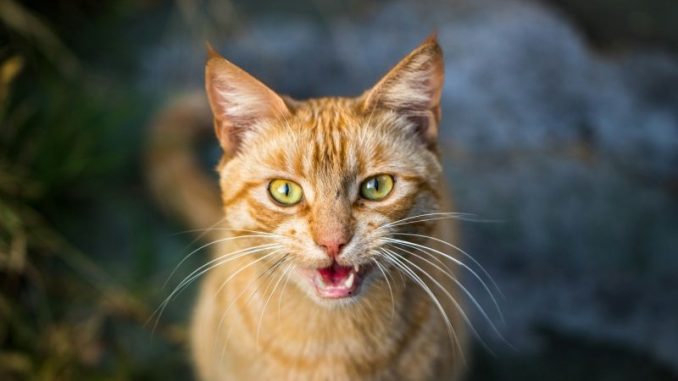
Unique Form of Communication
Cat meow after eating: what does it mean? Meowing is a fascinating aspect of feline behavior that sets cats apart from other animals. Unlike some pets that communicate through barks or chirps, cats have developed meowing as their primary way to interact with humans. It’s like their special language just for us!

Communication with Humans
Have you ever noticed that cats rarely meow at each other? That’s because they reserve this form of communication specifically for us, their beloved human companions. When a cat meows, it’s like they’re saying, “Hey, I want to talk to you!” It’s a way for them to grab our attention and convey their needs and emotions.

Insights into Behavior
Gaining insights into feline behavior can be quite valuable when it comes to understanding why cats meow after eating. Whether they are seeking attention, expressing contentment, or communicating a desire for more food, their post-meal meows can tell us a lot about how they are feeling. So, the next time your furry friend meows after a meal, pay attention – they might be trying to tell you something important!
Reasons for a Cat Meow After Eating
Seeking Attention or Affection from Their Owners
When your cat meows after eating, it might be seeking attention or affection from you. Cats can use their vocalizations to communicate their need for interaction and companionship. By responding positively to their meows, you can reinforce the bond between you and your feline friend.
Expressing Contentment or Satisfaction After a Meal
Meowing after eating can also be a sign of contentment and satisfaction. Just like humans might let out a satisfied sigh after a delicious meal, cats may express their happiness through meowing. It’s their way of saying, “Thanks for the tasty food, I’m feeling good!”

Communicating a Desire for More Food or Treats
If your cat meows persistently after finishing its meal, it could be signaling a desire for more food or treats. Cats are known for their love of food, and they might use meowing as a way to communicate that they want an extra snack or a special treat. Pay attention to the frequency and intensity of the meows to understand their cravings better.
By understanding these reasons for meowing after eating, you can decode your cat’s behavior and strengthen your relationship with them. Remember, every meow has a message behind it, and it’s up to us to listen and respond accordingly.
Habitual Behavior
Cats are creatures of habit. If your cat has developed a routine of meowing after meals, it could simply be a learned behavior. Over time, they may have realized that this action gets them attention or additional treats.
Health-Related Reasons for a Cat Meow After Eating
Digestive Issues: Cat Meow After Eating: Signs of Satisfaction or Discomfort?
If your cat is experiencing discomfort or pain after eating, they might meow to communicate this distress. Conditions like indigestion, food allergies, or gastrointestinal problems can cause discomfort that leads to vocalization.
Hunger Pangs
Sometimes, cats may not feel fully satiated after their meal and will meow to indicate they are still hungry. This could be due to insufficient portion sizes or high energy needs that aren’t being met by their current diet.
How to Respond to Your Cat’s Post-Meal Meows
Observe and Analyze
Pay close attention to when and how your cat meows after eating. Note any patterns or changes in behavior that could provide clues about the underlying cause.
Consult a Veterinarian
If you suspect health issues are causing your cat’s post-meal vocalizations, it’s essential to consult with a veterinarian. They can help diagnose any potential problems and recommend appropriate treatments or dietary adjustments.
Adjust Feeding Practices
Consider adjusting your feeding practices based on your observations. This might include changing portion sizes, altering feeding times, or experimenting with different types of food to see what best satisfies your cat’s needs.

Interpreting the Different Types of Meows
Pitch, Duration, and Intensity
When your feline friend meows after a meal, pay attention to the nuances in their vocalizations. The pitch, duration, and intensity of their meows can convey a variety of messages that reveal their emotional state and needs.
High-Pitched Meow: A Friendly Greeting
A short, high-pitched meow from your cat after eating may be their way of greeting you or requesting your attention. It’s like a little “hello” or “hey there” in cat language. So, next time you hear this cheerful meow, know that your furry companion is acknowledging your presence.
Low-Pitched Meow: Signaling Discomfort or Demand
On the other hand, a longer, lower-pitched meow post-meal could indicate that your cat is feeling discomfort or has a specific demand. It might be their way of expressing dissatisfaction with something or letting you know they need something urgently. Understanding this subtle difference can help you address their needs effectively.
Decoding Your Cat’s Meows
By paying close attention to the pitch, duration, and intensity of your cat’s meows after eating, you can decipher their unique language and respond accordingly. Whether they are seeking your attention, expressing satisfaction, or communicating a desire for more food, your response plays a crucial role in strengthening your bond with your feline companion.
Remember, every meow tells a story – it’s up to you to listen and understand!
Feline Communication Beyond Meowing
Understanding Body Language in Cats
Cats are masters of non-verbal communication, using their bodies to express a wide range of emotions and intentions. Tail movements, ear positions, and even whisker orientation can all provide valuable insights into what your feline friend is feeling.
Deciphering Other Vocalizations
While meowing is the most common vocalization, cats have a diverse range of other sounds they use to communicate. Purring, for example, is often associated with contentment and relaxation, while chirping can signal excitement or anticipation. On the other hand, hissing is a clear sign of fear or aggression.
Combining Vocalizations with Body Language
Understanding the vocalization patterns of cat meow after eating: For a complete understanding of your cat’s communication, it’s essential to consider both vocalizations and body language together. A purring cat with a relaxed posture is likely happy and content, while a hissing cat with flattened ears may be feeling threatened or scared.
Building a Stronger Connection
By paying close attention to your cat’s body language and vocal cues, you can deepen your bond and strengthen your ability to meet their needs effectively. Responding appropriately to their signals can enhance trust and understanding between you and your feline companion.
Encouraging Positive Interactions
Responding to Your Cat’s Meows
When your cat meows after eating, it’s essential to respond positively to reinforce communication. Acknowledge their vocalization with a gentle tone and offer affection if they seek it. This positive reinforcement helps strengthen the bond between you and your feline friend.
Providing Mental Stimulation and Playtime
To prevent attention-seeking meows, engage your cat in mental stimulation and playtime. Interactive toys, puzzle feeders, and regular play sessions can keep your cat mentally and physically stimulated, reducing the need for excessive vocalizations.
Conclusion: Cat Meow After Eating: A Guide for New Cat Owners
Understanding why cats meow after eating illuminates key aspects of feline communication and behavior. Meowing, specifically adapted for human interaction, serves as a multifaceted tool through which cats express their needs, seek attention, and convey emotions. By closely observing the nuances in their vocalizations—such as pitch, duration, and intensity—alongside their body language, pet owners can better interpret their feline companion’s signals.
Meowing after a meal can indicate various states, whether it be satisfaction and contentment, a desire for additional food, or simply a bid for attention and affection. Recognizing these cues and responding appropriately fosters a more profound bond, ensuring cats feel understood and well-cared for. Additionally, incorporating mental and physical stimulation into a cat’s routine can mitigate excessive meowing due to boredom or attention-seeking, thus promoting a more harmonious household.
Each cat is an individual with its unique communication style, making it critical for pet owners to observe and adapt to their specific feline friend’s behaviors. By doing so, owners can ensure not just the well-being of their pets, but also enrich the companionship they share. This heightened understanding and responsiveness enhance the mutual relationship, leading to a more fulfilling and emotionally connected experience for both cat and owner.





A lot of interesting cat information that I did not know, and nice pictures. I don’t have cats myself but my younger son (at college) has two cats.
Thank you for your thoughtful words! I’m delighted to hear that you found the information and pictures engaging. It’s wonderful to know that your son has two cats; I’m sure they bring him a lot of happiness!